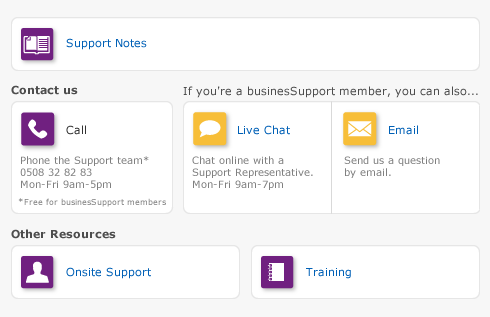Sales > Reviewing your sales information
|
Business Insights
|
Use Business Insights to analyse sales and customer information.
|
|
|
The To Do List displays all open sales, recurring sales and orders sorted by overdue dates.
|
||
|
Analyse Receivables
|
||
|
Analyse Sales
|
||
|
Sales reports help you keep track of your sales activities.
|
||
|
Sales history lets you view seven years of sales for an item, a customer or an employee.
|
||
|
Sales Register
|
The Sales Register window gives you a complete picture of your sales activity—open and closed invoices, orders, quotes, returns, credits and so on.
|
|
|
Find Transactions
|
Find Transactions helps you find individual sales transactions quickly.
|
|
|
Transaction Journal
|
The Transaction Journal lists journal entries of your sales and other transactions.
|
Business Insights presents a summary of your sales information, including which customers owe you money and how much money is overdue. You can also see how much your customers owe you for each ageing period, as well as the sales history of your customers.
To find information specific to your needs, sort the table columns by clicking a column heading. For example, you can sort the list of outstanding invoices to find the most overdue invoice or the largest overdue amount.
|
1
|
Go to the Accounts command centre and click Business Insights. The Business Insights window appears.
|
|
2
|
View the Customers who owe me money panel.
|
This panel shows the total you are owed and details of each overdue customer payment (based on their invoiced credit terms), including the number of days overdue.
|
3
|
Click Analyse customers to view graphs and information about the money your customers owe you and the payment history of each customer.
|
|
▪
|
Contact customers for overdue payments Identify which customer payments are the most overdue or which customers owe you the most money.
|
|
▪
|
Renegotiate a customer’s credit terms View the customer’s outstanding balances and payment history, such as the average number of days it takes for them to pay you.
|
|
4
|
If you want to save a graph as an image so you can print it or insert it into a document, right-click the graph and click Save As. Choose where you want to save the image and click Save.
|
|
1
|
|
2
|
Click the A/R tab. A list of all unpaid sales appears.
|
The Overdue column shows the number of days an invoice is overdue. (A negative number in the Overdue column indicates that the payment is not yet due.) The number of days an invoice is overdue is calculated by checking the original date of the invoice, comparing it to today’s date and looking at the customer’s credit terms.
|
3
|
If you want to send a collection letter to customers with overdue payments:
|
|
a
|
Select those customers by clicking in the select column (
|
|
b
|
If you have installed OfficeLink, click Mail Merge to create the letter directly in your word processor. Otherwise, click Disk, choose a file format and click Save.
|
|
1
|
In any command centre, click the Analysis down arrow (
|
|
2
|
Click Filters and choose the periods and any other criteria for which you want to view receivables information.
|
|
3
|
To analyse your sales activities
The Analyse Sales window provides various illustrations—as graphs or as lists—of your sales activities.
|
1
|
In any command centre, click the Analysis down arrow (
|
|
2
|
Click Filters and choose the sales figures, periods and other criteria you want to view sales activity for.
|
|
3
|
|
4
|
Select the display options in the Analyse Sales window to view charts showing your sales activities.
|
There are several sales reports that can help you track your sales activities. For example, you can run an Aged Receivables Summary report to view your customers’ current balances sorted by ageing periods. The Sales Item Summary report shows you which inventory items are selling best. The Referral Source report is useful for finding out which referral source is bringing your business the most money.
|
1
|
|
2
|
Click the Sales tab. A list of available sales reports appears.
|
|
1
|
Display the Item Information window for an item or the Card Information window for a customer or an employee.
|
|
2
|
Click the History tab. The History tab displays a total of seven years of sales history for the item or card: the five years preceding the current financial year (as displayed in the Company Information window), the current financial year and the next year.
|
note : Employee sales history
To record an employee’s sales history, that employee must be selected as the salesperson in the Sales window when the sale is recorded.

